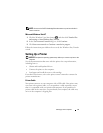
Setting Up Your Computer 35
Setting Up Your Computer
Connecting to the Internet
NOTE: ISPs and ISP offerings vary by country.
To connect to the Internet, you need a modem or network connection and an
Internet service provider (ISP). Your ISP will offer one or more of the
following Internet connection options:
• DSL connections that provide high-speed Internet access through your
existing telephone line or cellular telephone service. With a DSL
connection, you can access the Internet and use your telephone on the
same line simultaneously.
• Cable modem connections that provide high-speed Internet access
through your local cable TV line.
• Satellite modem connections that provide high-speed Internet access
through a satellite television system.
• Dial-up connections that provide Internet access through a telephone line.
Dial-up connections are considerably slower than DSL, cable, and satellite
modem connections.
• Wireless Wide Area Network (WWAN) or Mobile Broadband technology
provides a connection to the Internet using cellular technology at
broadband rates.
• Wireless Local Area Network (WLAN) connections use high-frequency
radio waves to communicate. Typically, a wireless router is connected to
the broadband cable or DSL modem that broadcasts the Internet signal to
your computer.
If you are using a dial-up connection, connect a telephone line to the modem
connector on your computer and to the telephone wall connector before you
set up your Internet connection. If you are using a DSL, cable, or satellite
modem connection, contact your ISP or cellular telephone service for setup
instructions.


















